Active filters:
- Remove this filter Category: Agronomy & Horticulture
Available filters Toggle display
- Price
Publications
Need to be tax-exempt?
Contact Laura Tharnish before ordering.
ltharnish2@unl.edu or 402-472-1576
-
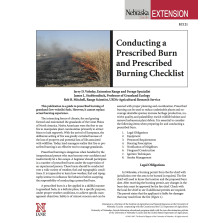
Conducting a Prescribed Burn and Prescribed Burning Checklist
$2.75Not available online
A guide to prescribed burning of grassland (low-volatile) fuels. It covers legal obligations; equipment; burning prescriptions; fireguard construction; ignition techniques; smoke management; personnel requirements; and includes a checklist of required forms and activities to follow. Learn More -
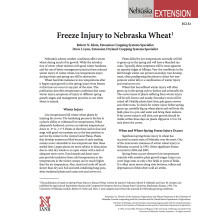
Freeze Injury to Nebraska Wheat
$1.00Describes temperature conditions that cause winter injury, symptoms of injury at different spring growth stages, effects on yield, and management practices to use when wheat is injured. Includes 26 photos to aid in plant growth stage identification and illustrate injury at various growth stages. Learn More -
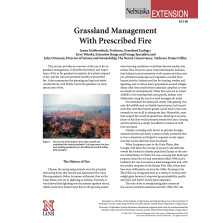
Grassland Management with Prescribed Fire
$1.00Not available online
This publication provides an overview of the use of fire in grassland management. It describes the history and importance of fire in the grassland ecosystem, how plants respond to fire, and the uses and potential benefits of prescribed fire. It summarizes fire planning and legal and safety considerations and provides guidance on special uses of fire.
Learn More -
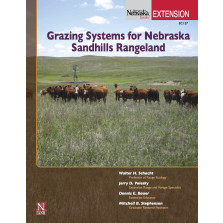
Grazing Systems for Nebraska Sandhills Rangeland
$1.00In a grazing management plan grazing systems provide a sequential movement of animals among pastures with properly timed grazing and recovery periods within a season. The four major grazing systems used in the Nebraska Sandhills are discussed and seasonal charts are provided for each for various grazing strategies. It includes comparative advantages and management implications of each and illustrations of various systems in regard to stocking density and timing of grazing and effect of timing on grass production. It also includes a glossary of grazing terms and briefly describes other grazing options.
Grazing systems include:
- Continuous grazing
- Short-duration grazing
- Deferred-rotation grazing
- 50 pasture system
-
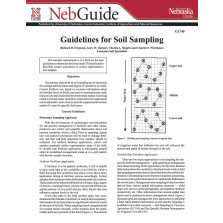
Guidelines for Soil Sampling
$1.00Not available online
Soil samples representative of a field are the best guidelines to determine fertilizer needs. This publication describes proper procedures to collect representative soil samples and includes a diagram on how to sample a furrow-irrigated field.
Topics include:
- Descriptions of sampling approaches for uniform fertilizer application and variable rate fertilizer application, including grid and zone approaches
- Selecting proper sampling depth
- Collecting soil cores
- Soil sampling equipment
- Timing of sampling
- Handling of samples
-
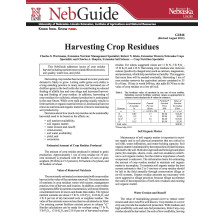
Harvesting Crop Residues
$1.00Harvesting of crop residue can provide a resource for livestock feed and the production of cellulosic biofuel. Learn how to evaluate how much crop residue can be sustainably harvested from your fields based on soil nutrient availability, soil organic matter, water erosion and runoff, wind erosion, soil water availability, and yield.
Topics covered in this four-page NebGuide include:
- Estimated amount of crop residue produced
- Value of removed nutrients
- Soil organic matter
- Water erosion and runoff
- Wind erosion
- Soil water
- Manure application
- Cover crops
- Harvest equipment limitations
- Estimating the amount of crop residue to harvest
-

Home Landscape
$6.50Learn MoreUnderstanding the basics of landscape design helps you take a problem-solving approach to design a landscape that fits your situation. By identifying the constraints of your site and creatively applying basic design principles, you can create a functional landscape that meets your needs, is environmentally sound, aesthetically pleasing, and demonstrates your own sense of style. This guide, which is well illustrated with photographs and diagrams, includes tools to help you achieve the look you want.
Highlights include:
- Step-by-step guide to working through the landscape design process
- Illustrated explanations of design principles showing how to apply them to your yard
- Worksheets to help you analyze your yard and identify how you want to use your outdoor spaces
- Guidelines for choosing the "right" plants
- A summary of the types of landscape design assistance available
This book was co-published with Iowa State University Cooperative Extension.
-
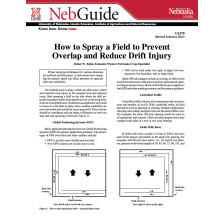
How to Spray a Field to Prevent Overlap
$1.00The method used to spray a field can affect pest control and potential injury to the targeted crop and adjacent crops. Proper spraying techniques for various situations are outlined and illustrated. A table shows how changing the sprayer speed can affect pressure on sprayers with rate controllers.
Topics include:
- Benefits of using GPS for sprayer guidance
- Spraying fields with rows and without rows
- Spraying field borders and while turning
- Handling irregular shaped fields
- Proper swath overlap
- Field speed
- Reducing drift injury
-
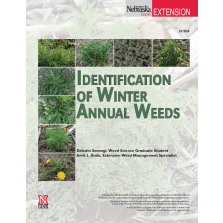
Identification of Winter Annual Weeds
$1.00This Extension Circular provides information and color photos to identify characteristics of winter annual weeds commonly found in Nebraska. Accurate identification is essential to effectively managing them. Learn More -
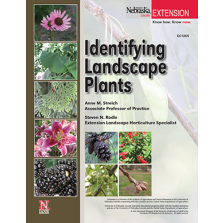
Identifying Landscape Plants
$4.25Plant identification is a very important basic skill for people wanting to make correct management decisions for their landscape plants. Application of pest management strategies and timing of management practices, such as pruning, fertilizing, and planting, all depend on correct plant identification. Learn More